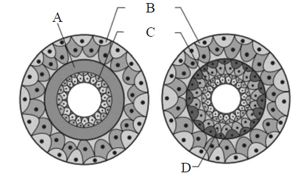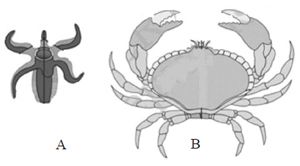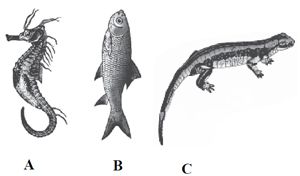Refer the following animals and identify those which have a fluid filled body cavity with a complete lining derived from mesoderm.
(i) Sycon (ii) Butterfly
(iii) Nereis (iv) Sea fan
(v) Scorpion (vi) Pila
(i) and (iii) only
(ii) and (iv) only
(ii), (iii), (v) and (vi) only
All of these
Correct Answer :
C. (ii), (iii), (v) and (vi) only
Butterfly, Nereis, scorpion and pila are animals which have a fluid filled body cavity with a complete lining derived from mesoderm, Hence, called as coelomate animals.
Related Questions
Which of the following animals are bilaterally symmetrical?

1 & 2
2 & 4
3 & 4
1 & 3
Which of the following is a living fossil?
Balanoglossus
Echinus
Ancylostoma
Limulus
In ctenophora, the body bears _______ external rows of ciliated comb plates, which help in locomotion.
five
six
seven
eight
In amphibians, respiration occurs through
gills
lungs
skin
all of these
Refer the following animals and identify those which have a fluid filled body cavity with a complete lining derived from mesoderm.
(i) Sycon (ii) Butterfly
(iii) Nereis (iv) Sea fan
(v) Scorpion (vi) Pila
(i) and (iii) only
(ii) and (iv) only
(ii), (iii), (v) and (vi) only
All of these
Which of the following class is being correctly described by given statements (i - iv)?
(i) All living members of this class are ectoparasites on some fishes.
(ii) They have a sucking and circular mouth without jaws.
(iii) Circulation is of closed type.
(iv) They are marine but migrate for spawning to fresh water. After spawing, within a few days they die.
Cyclostomata
Chondrichthyes
Osteichthyes
Amphibia
Heart is three - chambered in reptiles, except
turtle
Chameleon
Naja (Cobra)
crocodile
Which of the following pairs of animals comprises jawless fishes?
Mackerals and rohu
Lampreys and hag fishes
Guppies and hag fishes
Lampreys and eels
Which of the following features distinguish mammals from other vertebrates ?
Hairy skin and oviparity
Hairy skin and mammary glands
Mammary glands and teeth
Pinna and teeth
Which of the following feature is not correct regarding the figure given below?

It is an aquatic form.
Circulatory system is of open type.
It possesses parapodia for swimming.
Neural system consists of paired ganglia connected by lateral nerves to a double ventral nerve cord.
Which of the following possesses electric organs and belongs to class chondrichthyes?
Torpedo
Petromyzon
Trygon
Exocoetus
Match the phylum given in column - I with the special features present in them given in column - II and choose the correct option.
| Column -I | Column- II |
|---|---|
| (Phylum) | (Special features present) |
| A. Porifera | I. Mammary glands |
| B. Mollusca | II. Cloaca |
| C. Ctenophora | III. Choanocytes |
| D. Amphibia | IV. Radula |
| E. Mammalia | V. Comb plates |
A III; B IV; C V; D II; E I
A IV; B III; C V; D II; E I
A III; B IV; C II; D V; E I
A III; B V; C IV; D II; E I
A student brought home a strange animal which he found outside under a rock. It had moist skin, a complete digestive tract, a ventral nerve cord, and had gone through torsion. Identify the phylum of the animal.
Porifera
Annelida
Mollusca
Echinodermata
Which of the following characteristic distinguish arthropoda from annelids and molluscs ?
An external skeleton made of chitin (a polysaccharide) and protein rather than a shell made chiefly of mineral salts.
Subdivision of the legs into movable segments.
Distinct group of muscles, derived from many body segments, that move the separate parts of the exoskeleton.
All of the above
Which of the following feature in birds indicates their reptilian ancestory ?
Eggs with a calcareous shell
Scales on their hind limbs
Four-chambered heart
Two special chambers-crop and gizzard in their digestive tract
When any plane passing through the central axis of the body divides the organism into two identical halves, the organism is called ___________.
radially symmetrical
bilaterally symmetrical
asymmetrical
metamerically segmented
Which of the following phylum is being described by the given statements?
(i) These are primitive multicellular animals and have cellular level of organization.
(ii) Digestion is intracellular.
(iii) They have a water transport or canal system.
(iv) They reproduce asexually by fragmentation and sexually by formation of gametes.
Porifera
Ctenophora
Coelenterata
Platyhelminthes
The figure given below shows the germinal layers marked as A, B, C and D. Identify the label showing undifferentiated layer and its location?

A, Between B & C
B, Between A & C
C, Between C & D
D, Between A & B
The given figures of animals (A & B) are distinguished on the basis of symmetry. Select the correct option which shows the type of symmetry and its description against the animals.

A : Biradial, organisms is divided into unequal halves by any plane through the central axis.
B: Bilateral, body is divided into equivalent right and left halves by only one plane.
A: Asymmetrical, organisms is not divided into equal halves by any plane through the central axis.
B: Radial, in which any plane passing through the central axis of the body divides the organism into two identical halves.
Identify the correct characteristics of porifera.
- Commonly known as sea walnuts.
- Presence of ostia and collar cells.
- Exhibit tissue level of characteristics.
- It is the largest phylum of animal kingdom.
- The body is supported by spicules and sponging fibers.
- Contains cnidocytes which is used for defense, anchorage and capturing of prey.
(ii), (v) only
(i), (ii), (vi) only
(i), (ii), (iii), (iv) only
All of these.
Which of the following belong to phylum arthropoda?
Bombyx and Apis
Laccifer and Anopheles
Locusta and Limulus
All of the above
Refer the figures A, B, C and D given below. Which of the following options shows the correct name of the animals shown by the figures A, B, C and D ?

A – Locust, B – Scorpion, C – Prawn, D – Pila
A – Locust, B – Prawn, C – Scorpion, D – Pila
A – Locust, B – Scorpion, C – Prawn, D – Snail
A – Butterfly, B – Scorpion, C – Prawn, D – Pila
The transition from aquatic to terrestrial lifestyles required many adaptations in the vertebrate lineage. Which of the following is not one of those adaptations ?
Switch from gill respiration to air-breathing lungs.
Improvements in water resistance of skin.
Alteration in mode of locomotion.
Development of feathers for insulation.
Animals like annelids, arthropods, etc. where the body can be divided into identical left and right halves in only one plane, exhibit___________symmetry.
radial
bilateral
asymmetrical
non- symmetrical
Which one of the following groups of animals is correctly matched with its characteristic feature without even a single exception ?
Reptilia : possess 3 - chambered heart with one incompletely divided ventricle.
Chordata : Possess a mouth provided with an upper and lower jaw.
Chondrichthyes : Possess cartilaginous endoskeleton.
Mammalia : Give birth to young one.
Refer the figures A, B and C and choose the correct option which shows animals that regulate buoyancy with the help of air bladder.

A and B
A and C
B and C
All of the above.
Which of the following characteristics is correct for reptilia?
Body covered with dry and cornified skin, scales over the body are epidermal, they do not have external ears.
Body is covered with moist skin and is devoid of scales, the ear is represented by a tympanum, alimentary canal, urinary and reproductive tracts open into a common cloaca.
Fresh water animals with bony endoskeleton and airbladder regulate buoyancy.
Marine animals with cartilaginous endoskeleton and body is covered with placoid scales.
Which one of the following features is common in silverfish, scorpion, dragonfly and prawn?
Three pairs of legs and segmented body.
Chitinous cuticle and two pairs of antennae.
Jointed appendages and chitinous exoskeleton.
Cephalothorax and tracheae.
Few cnidarians like corals have a skeleton composed of
calcium hydroxide
calcium sulphate
calcium carbonate
sodium bicarbonate
Identify the figures A, B and C and choose the correct option.

A - Male Ascaris, B - Hirudinaria (leech), C- Nereis
A - Female Ascaris, B - Nereis, C-Hirudinaria (leech)
A - Female Ascaris B- Hirudinaria (leech), C - Nereis
A - Male Ascaris, B - Nereis, C- Hirudinaria (leech)
